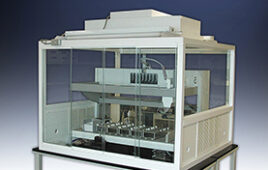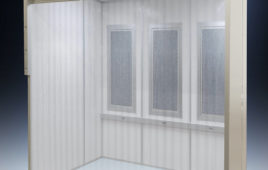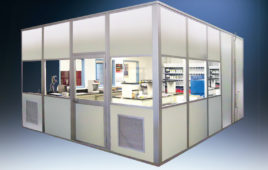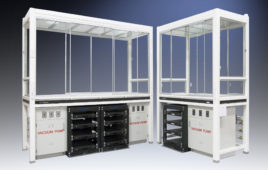The staff at the National Institute of Standards and Technology, Boulder, Colo., is used to working in cobbled-together cleanroom facilities. The Quantum Electronics and Photonics Division, which concentrates on microfabrication, nanofabrication, and related efforts, has endured a series of space adjustments since the campus’s first cleanroom was created in 1971. By the turn of the century, the team’s much-renovated 5,000-ft2 cleanroom was showing its age.
Today, the group is enjoying the enhanced capabilities of a state-of-the-art, Class 100 cleanroom space: 18,000 ft2 inside the new 297,000-ft2 Precision Measurement Laboratory (PML). The building, an extension of the existing Building 1, includes flexible instrument and nanotechnology laboratories, as well as lab support space, offices, and meeting areas. (About $85 million of the $118.6 million project budget came from federal stimulus funding.)
The Quantum Electronics and Photonics Division is known for world-leading electrical standards, record-setting micro-sensors for homeland security, and components for quantum computers. The new cleanroom allows precision manufacturing of custom microfabricated devices for NIST’s own research, as well as fabrication of unique devices used by external partners for applications such as precision astronomical research and measurements. Device types include superconducting, magnetic, optoelectronic, and micro-electromechanical.

The Precision Measurement Laboratory is conveniently connected with an existing facility, Building 1. Photo: HDR Architecture Inc.; Andrew Pogue Photography
The improved facility should help NIST maintain its leadership position in multiple specialty areas, such as fabrication of quantum standards that are used by metrology labs worldwide. The division is also well-known for its ability to make transition-edge sensors (TES), in which energy deposited by incoming photons or particles forces a transition from the superconducting to the normal state.
Until recently, as many as half the nanoscale devices produced by the team were unusable, due to issues with air quality and temperature control. The new facility, with its much more stable prototyping environment, should eliminate such problems. Dave Rudman, leader of the Quantum Devices Group, says, “Basically, what has been done is to take a 25-year-old facility that was never built to be a true cleanroom, and bring it into the 21st century. It is clear evidence of how important microfabrication and related efforts are to NIST-Boulder that we have devoted fully one quarter of the space in our new Precision Measurement Laboratory building to this cleanroom resource.”
Planned circulation and service
Designed and engineered by HDR Architecture, Alexandria, Va., the PML building is organized with its lab spaces on one side of a circulation spine, or “pedestrian street,” and office areas on the other side. Lab areas are divided into two primary blocks: the cleanroom, and non-cleanroom instrument labs.

A chase between instrument bays contains utilities, pumps and toxic gas monitoring sensors, leaving the instrument areas clutter-free. Photo: NIST
The cleanroom modules are arranged along both sides of a clean corridor, with access from the “pedestrian street” via a gowning area and airlock vestibule. A wipe-down station allows equipment to be cleaned thoroughly before it is brought into the room. Surrounding the cleanroom is a service corridor for the delivery of supplies, chemicals, and equipment; pass-throughs facilitate handling. A separate observation corridor permits views into and through the space.
Numerous chases within the large cleanroom allow easy access to instruments and tools. Toxic-gas monitoring provides sophisticated levels of detection for 10 different hazardous gases. Among the 60 precision tools now available to the team are a commercial-grade stepper for optical lithography, allowing feature sizes of 0.35 μm; 15 deposition tools and 13 dry-etch tools; a scanning electron microscope suitable for rudimentary e-beam lithography; and a two-chamber unit for molecular beam epitaxy, featuring separate chambers for gallium nitride and gallium arsenide deposition.

Multiple copies of similar tools, with ample workspace, improve throughput. The cleanroom houses about 60 tools, half of which are new. Photo: HDR Architecture Inc.; Andrew Pogue Photography
The high-tech building also makes ample provisions for staff comfort. The enclosed private offices are situated on an exterior wall for daylighting, with flex office and support space toward the interior, adjacent to the main corridor. Staff lounges, vending areas, and small conference spaces allow the team to interact, share information, and relax. Information kiosks, artwork, and other interior design features punctuate the central “street.”
Enhanced capabilities
Though these quality-of-life amenities make the building pleasant, it’s the highly controlled cleanroom space that represents the greatest benefit to the Quantum Electronics and Photonics Division, and ultimately to their internal and external customers.
Future projects now possible because of enhanced cleanroom capabilities include manufacturing of advanced multi-zone surface-electrode ion traps for quantum information processing and simulations; microfabricated “chip scale” atomic magnetometers for use in neuroscience; super-sensitive atomic force sensors using quantum-limited micromechanical detectors; and integrated microfluidic and microelectronic circuits for biosensors.

The cleanroom modules are arranged along both sides of a clean corridor, with access from the building’s main “pedestrian street” via a gowning area and airlock vestibule (rear). Photo: HDR Architecture Inc.; Andrew Pogue Photography
Bob Hickernell, head of the division, says, “The expanded ability to go rapidly from invention to realization of microfabricated devices will enable the NIST-Boulder research staff to realize a wide range of breakthroughs in microfabricated quantum standards and measurement systems.”
This article appeared in the January 2013 issue of Controlled Environments.




